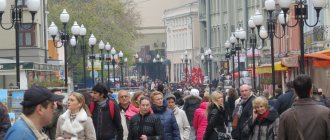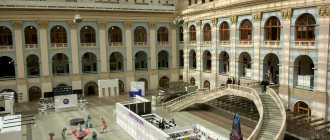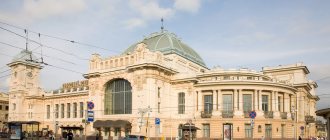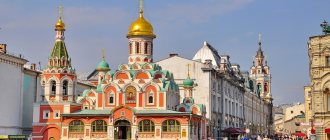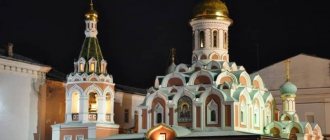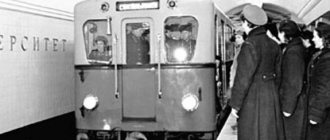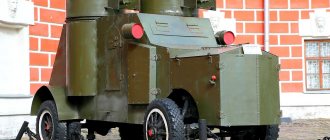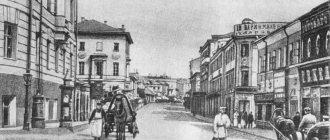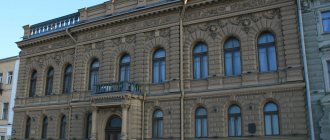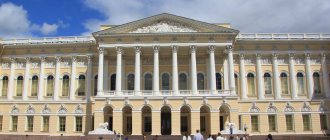The first monument in Moscow
Nikolai Andreevich Andreev is one of the famous sculptors of the 20th century. It was he who made the first monument to Gogol in Moscow. This is one of the most outstanding sculptures. After its opening (1909), the monument received many negative reviews.
Citizens are not used to seeing sitting figures, especially those made in the style of realism. Everyone expected to see the writer’s figure in full height, solemnly towering over the boulevard. The monument to Gogol did not live up to expectations. N.A. Andreev moved away from standard academicism and showed imagination and initiative. In his sculpture, the Russian writer is depicted in a moment of mental anguish. Gogol lay down on a stone and thinks about something or greatly regrets something. But, despite harsh criticism, Muscovites soon got used to the new monument. And at the end of the year, N.A. Andreev read not critical reviews, but positive reviews of his work.
Second attempt to install the monument
The monument to Gogol on Arbat Square by sculptor N. A. Andreev did not last long. J.V. Stalin did not like the monument, he considered it too pessimistic, and V. Mukhina shared the same opinion. Therefore, in 1950, a competition was announced for the production of a new monument. The winner was the sculptor Nikolai Vasilyevich Tomsky. The government liked his vision of the writer better.
The monument, opened in 1951, was made in full height in a solemn pose. There was no trace of any detailed study. The criticism of the townspeople was again cruel. For 50 years, they had become so accustomed to the mourning figure of the writer, who amazed everyone with her portrait resemblance, that they reacted poorly to the new monument to Gogol on Arbatskaya. Although the government expressed gratitude to the sculptor, N.V. Tomsky himself considers this sculpture one of his most unsuccessful works.
19th century crowdfunding
The first literary monument in Moscow was the bronze Pushkin on Strastnoy Boulevard, created by sculptor Alexander Opekushin. Its opening took place with great fanfare. Around the same time, in the summer of 1880, the idea arose to immortalize Gogol in bronze. The capital was supposed to, in the apt expression of Alexei Potekhin, a prominent theater figure of those years, turn into a “pantheon of Russian literature.”
The Society of Lovers of Russian Literature, of which Gogol was elected a member during his lifetime, quickly launched a fundraiser throughout the country. An interesting detail: the treasurer of the society was a man with a surname that coincides with the title of one of Gogol’s most mystical stories - Andrei Evdokimovich Nos. Accumulating a sufficient amount turned out to be a slow task - the capital exceeded 50 thousand rubles only after ten years of collecting, by the end of 1890.
The next step was the creation of a committee for the construction of the monument. Its first meeting took place in the spring of 1896, when the Gogol fund reached 70 thousand.
In 1900, with the approval of Nicholas II, Arbat Square was chosen as the location for the monument. Among the rejected options were Trubnaya, Lubyanskaya and Teatralnaya squares, as well as Strastnoy and Rozhdestvensky boulevards.
In Nizhyn
In 1881, the world's first monument to Gogol was unveiled. It was made by the famous sculptor of St. Petersburg P. P. Zabello. Why was the first monument erected in the city of Nizhyn? It was here that the Russian writer received his education. An interesting fact is that the sculptor P. P. Zabello grew up in the city of Nizhyn.
The monument to the writer is made in the form of a bust. Gogol bowed his head and looked at everyone passing as if from above, with a half-smile on his lips.
The writer is wearing a raincoat. The sculptor’s interesting idea was connected with this item of clothing. P. P. Zabello laid out the folds of the cloak in the form of his profile. But to find a unique autograph of the author you will have to try.
In St. Petersburg
In the Northern capital of our homeland, the monument to Gogol is located on Malaya Konyushennaya Street. The sculpture was made by M. V. Belov, a young talent. The monument to Gogol on Gogol Boulevard bears some resemblance to the sculpture of the writer in Moscow. But unlike Tomsky’s work, Belov worked on the figure of N.V. Gogol in great detail. The sculpture represents the writer in full growth. He was thinking about something, folded his arms over his chest and bowed his head.
Surprisingly, the initiative to open the monument belongs not to the city administration, but to patrons of the arts. Their names are written on the back of the pedestal. The bronze figure of the writer harmonizes well with the surrounding space. The monument was surrounded by an iron grille, and the lanterns that illuminate the figure of the writer at night were made in the same style.
Features of the architectural composition
The sculpture, 3.4 meters high, is made of bronze, and the one and a half meter pedestal is made of granite mined near Vyborg. The composition as a whole looks quite impressive, having a total height of almost 5 meters.
On the base of the monument is written “To Nikolai Vasilyevich Gogol,” and on the opposite side there is a long list of organizations and individuals who contributed to its construction. The composition is surrounded by a low wrought iron fence and four lanterns.
The bronze figure was cast on, the pedestal was polished and the inscriptions were cut out in the stone-masonry workshop of A.V. Rytov. The lanterns and grille were manufactured by the Aspect foundry.
In Volgograd
The monument to Gogol in this city was opened in 1910. It is still well preserved, although it was damaged by the events of the revolution and world wars. The monument to Gogol is considered one of the first erected in Volgograd. Its sculptor is I.F. Tavbia. Funds for the monument were collected by townspeople who wanted to honor the memory of the great Russian writer in this way. Today, the bust of Gogol stands on a modern pedestal, but the appearance of the monument itself leaves much to be desired.
The writer’s face and clothes are stained with oxidized metal, and his facial features are slightly deformed from bullets. Today you can see the bust of Gogol in the Komsomol Garden.
Dubious sculptor, questionable project
It is still unknown what backstage negotiations preceded the approval of N. Andreev’s project, but they voted unanimously for it (according to the conditions voiced by the committee, a single vote against vetoed the adoption of the sketch). Perhaps the decision really was forced: there was almost no time left. So, with grief in half, construction work began, widely covered by the press and causing lively discussion among Muscovites.
To begin with, the identity of the author raised questions. Outstanding representatives of the art of those times, Opekushin and Repin, highly appreciated the talent of the young sculptor. However, the public doubted: there was little experience in erecting monuments.
Shortly before the opening, the famous critic Sergei Yablonovsky called the monument a “terrible and nightmare” symbol and expressed the opinion that “many will not want it.” How I looked into the water!
In Kyiv
An interesting monument to Gogol was erected in the capital of Ukraine. The sculpture is not entirely standard. It, of course, cannot be compared with the first monument to Gogol on Arbat Square in Moscow, but it is still worth considering that it was erected long before the capital’s monument. The author of the Gogol monument in Kyiv is Alexander Skoblikov. His idea to depict a half-length sculptural portrait is original in that the writer’s cloak beautifully falls from the pedestal.
Gogol's right hand holds the book, and his left holds the tail of his cloak. The arms are crossed and the gaze is directed into the distance. One gets the impression that the writer is waiting for someone or peering at passing people.
There are two more monuments in Kyiv that are directly related to Gogol. One of them is the Rare Bird monument. This unusual creature rises next to the Paton Bridge. In one of the works of N.V. Gogol it was said that “a rare bird will fly to the middle of the Dnieper.” But sculptor Alexey Vladimirov decided that one would still fly, and the city administration agreed. Also in Kyiv there is a monument to the Nose. In its shape, it is very reminiscent of Gogol's nose. The sculpture is located on Desyatinnaya Street.
Bent Gogol
The sculpture depicted a man completely wrapped in a cloak, with his head bowed low. Bent over, falling absurdly to one side, Gogol sat in a chair and represented the world's sorrow incarnate, and his famous long nose almost touched his knees. The tetrahedral pedestal was framed by a copper strip - the bas-relief on it depicted heroes of the writer’s famous works. They did not attract criticism. But the figure itself is a classic!
Sample epigrams rained down: “Andreev made Gogol from “The Nose” and “The Overcoat””; “Gogol sits hunched over, Pushkin stands like Gogol.”
The wife of Leo Nikolayevich Tolstoy, Sofya Andreevna, who visited the opening, found the monument “disgusting” (as she wrote in her personal diary). It’s quite interesting that her great husband, a great classic of world literature, liked the monument.
In Rome
The monument to Gogol in Moscow on Gogol Boulevard cannot be compared with the sculpture that was erected in honor of the writer in Rome. In 2002, a new monument was unveiled in the capital of Italy. What connects N.V. Gogol with Rome? The Russian writer was fluent in Italian, and it was in the capital of Italy that a significant part of the work “Dead Souls” was written. According to Gogol, it was far from his homeland that he could write about it honestly and without embellishment. This is not surprising, because nostalgia for Russia pushes people to rethink their life values. Today, the works of N.V. Gogol are in great demand among Italians. Many works of the Russian writer have been translated into Italian.
The sculptor of the Gogol monument in Rome was Zurab Tsereteli. The sculpture is made in academic style. The writer is depicted without embellishment, he sits on a bench and holds his own head in his hands with a smiling grimace.
“The fight with the Bab-Yagas is useless”
The Russian Federation suddenly became concerned about the monument to Gogol. In March 2014, it was decided to dismantle the monument to the times of Soviet power on the former Prechistensky (now Gogolevsky) Boulevard, and in its place return the old one, the work of N. Andreev, which was originally erected here, back in 1909.
There is no unanimity of opinion in society on this matter. One part of the citizens believes that it is better to leave everything as it is, the other wants to “restore historical justice,” not wanting to take into account either considerations of expediency or the realities of the surrounding life (after all, at the moment there are more important problems in Russia). Someone might not be averse to it, but they are stopped by purely economic motives: experts say that rushing back and forth with such structures is not a cheap pleasure.
In Kharkov
The bust of the great writer was made by the sculptor B. W. Edwards. The bust of Gogol was installed in 1909. The writer holds his notes in one hand and a pen in the other hand. He holds these precious things tightly to his chest. Gogol's gaze is directed at the viewer.
During the Great Patriotic War, the bust was damaged. The bullet pierced the shoulder and arm, thereby deforming the sculpture. But during the restoration process these defects were not removed, since they are part of the history of the city. You can admire the sculpture on Poetry Square.
In Dnepropetrovsk
A monument to Gogol simply could not help but be erected in this Ukrainian city. After all, the famous Russian writer was born and raised in Ukraine. This period of his life is reflected in many works. N.V. Gogol honored and remembered Ukrainian culture and traditions.
The bust of the writer in Dnepropetrovsk was erected in 1959. The sculptor of this monument is A.V. Sytnik. Monuments to Gogol by the middle of the 20th century. have already decorated many Russian and Ukrainian cities. It is strange that the monument in Dnepropetrovsk does not stand out for its scope or originality. N.V. Gogol is depicted in an academic style. The writer's face and clothing are well detailed. You can look at the bust of the great Russian writer at the intersection of Gogol Street and Karl-Marx Avenue.
In Kaluga
Despite the fact that the monument to Gogol in Kaluga was opened quite recently, in 2014, it enjoys great interest from both city residents and tourists. Until recently, a small obelisk stood on the site of the bronze sculpture. The modern monument has a large span - 2.5 m. The author of the monument is the Moscow sculptor Alexander Smirnov. The installation location was not chosen by chance. After all, it was here, in Tsiolkovsky Park, that a Russian writer once lived and worked. Gogol's close friends gathered at his home and listened to excerpts from the second volume of Dead Souls, which, unfortunately, we do not have the opportunity to read.
An interesting fact about the monument: the initiator of its installation was local theater actor Valery Zolotukhin. He became so imbued with the writer’s work when he played in his play “The Inspector General” that he persuaded the administration to seriously take up the issue of installing the monument. And he achieved his goal. The city administration not only unveiled the monument, but also organized a festive concert on this day. A brass band was playing, dressed-up ladies and gentlemen in costumes tailored according to the fashion of the 19th century walked.
The sculpture installed in Kaluga depicts the writer at work. Gogol stands in thought next to the desk.
Writings are laid out on it, and there is also a pen and inkwell. The monument depicts Nikolai Vasilyevich at a moment of reflection. The writer stands slightly hunched over, his gaze directed at the ground. It is interesting that A. Smirnov decided to portray Gogol not in the writer’s usual raincoat, but in a dressing gown.
In Poltava
Sculptor L. Posen created a monument to Gogol in 1915. But the writer sat on the pedestal on Gogol Street only in 1934. Why was there such a delay? The first thing that prevented the installation was the Civil War. Then it was impossible to place the monument due to the outbreak of the First World War. But even after its completion, the government was against the installation of the sculpture. The fact is that N.V. Gogol was a nobleman, and the Bolsheviks considered it unnecessary to erect monuments that would in any way remind people of the tsarist power. Despite all the troubles, the monument was placed in its current location in 1934.
L. Posen created the sculpture in a sitting position. One leg of the writer is pushed forward, and the other is pulled under him. The pose is clearly relaxed. This is exactly how a person sits when he is thinking deeply about something. The writer is apparently thinking about the book he just read, because it is the one in his hands.
Future of monuments
To date, there are 11 monuments to N.V. Gogol. But this does not take into account the memorial plaques that are located in various cities. In memory of the great Russian writer, many museums were opened that are simply a must-see for all admirers of Russian classics.
Every year the government spends quite large sums on road construction. Restoration of municipal buildings is being carried out, but for some reason monuments are rarely sent for restoration. City administrations have different opinions on how to maintain the sculptures in proper form. Therefore, some monuments currently look excellent, while others, unfortunately, leave much to be desired. Undoubtedly, it is encouraging that every year in Russia there are more and more patrons of art who support art. Therefore, let’s hope that the monuments to Gogol and other outstanding figures of culture and art will not lose their presentable appearance, and they will be restored in a timely manner.
LiveInternetLiveInternet
It is noteworthy that the opening of the monument was not scheduled for Gogol’s birthday, but only for April 26 (old style) for the “best” reasons. The fact is that March 19, 1909 was Lent.
•••
♦In addition, the organizers of the celebrations feared that due to (possibly) inclement weather, the townspeople might not gather for the unveiling of the monument.
And here’s another “joke” to match Gogolevsky: on April 25, 1909, terrible bad weather, almost with sleet, hits Moscow. But, nevertheless, with a huge crowd of people in inclement weather on April 26, the opening of the monument took place!
•••
.♦ For the opening of the monument based on Andreev’s plaster model, St. Petersburg medalist A. Jacquard minted a commemorative medal in the amount of 303 copies (of which 300 in bronze, 2 in silver, 1 in gold)
♦ This event was preceded by the construction of the foundation of the monument in 1906 on Prechistensky Boulevard, in which gold and silver coins were placed, and on top - a copper plaque with an inscription.
•••
♦ However, the appearance of a new monument in Moscow did not cause general delight. There were numerous reproaches that he was unpatriotic, that he distorted the image of the great writer, who is so dear to truly Russian people.
“The monument is not suitable... it was erected not to a great man, but to some sick creature about whom we do not care.”
“This is a disease, this ending should not have been depicted.”
•••
♦Andreevsky’s “Gogol”, indeed, does not fit into generally accepted ideas about what a monument to a great man should be; the monument is indeed, in many ways, unconventional. And this concerned not only unusual plastic forms, but, most importantly, the general conceptual design.
National heroes appear in city squares in all their triumphant grandeur, evoking pride and inspiration in the audience, or, in any case, a feeling of belonging and closeness to their idols. And on Prechistensky Boulevard sat an alienated, broken and deeply unhappy man, withdrawn into himself.
•••
Donskoy Monastery, which is called a cemetery of architecture
♦ The monument by Andreev stood in its rightful place on the Boulevard for 42 years. In 1952, St. Andrew's Gogol was moved from Arbat Square to the Donskoy Monastery, to the Museum of Memorial Sculpture, where for several years, along with fragments of the destroyed Cathedral of Christ the Savior and the demolished triumphal arch, it was listed as a museum exhibit, which, perhaps, saved it from destruction .
In essence, both the tsarist and Soviet authorities only tolerated the monument to Gogol, and then only for the time being. When triumphant monuments to the “Great Leader” rose across the country, the sickly Gogol looked like obvious dissonance.
In his place, the leading master of socialist realism N.V. Tomsky erected “on behalf of the Soviet government” an official monument to Nikolai Vasilyevich - majestic and smiling. The tragedy of creativity was cancelled.
•••
Joseph Stalin’s hostility to the “sorrowful” Gogol: the Soviet leader did not like the “sad” sculpture, past which he had to regularly drive by car from the Kremlin to the Kuntsevskaya Dacha, and it was replaced with a “cheerful” one.
1920 – 1925
It is noteworthy that the “external” design for the new monument, more precisely, the bases of the lamp posts, remained the same.
Lion of the English Club on Tverskaya
An interesting recollection of Nikolai Andreev is that the prototype of these lions was the famous “and the lions on the gates..”. The same ones from the pylons of the gates of the “English Club” on Tverskaya, about which Alexander Sergeevich Pushkin wrote!
Of course, there are differences - those lions that “at the gate” rose on their front paws, and our “heroes” lay down. But the similarity of the lions’ faces, the “hairstyle” of their mane, and even the peculiar “fringe” on their paws is obvious...
1950
•••
In 1959, on the 150th anniversary of Gogol’s birth, at the request of the USSR Ministry of Culture, the monument was erected in the courtyard of the former house of A. S. Talyzin
♦ St. Andrew’s “Gogol” did not stay long in the Donskoy Monastery (a branch of the Museum of Architecture). During Khrushchev’s “thaw” they remembered him and found a quiet place, not far from the previous one. In 1956, it was moved to the courtyard of house No. 7 on Nikitsky Boulevard. The new location was chosen very well: the writer lived in this house for the last years and died in it.
♦ Gogol moved to a two-story Moscow mansion of the early 19th century in the winter of 1848, where his friend, Count Alexander Tolstoy, rented an apartment. Gogol lived in two small rooms on the first floor.
.
Cabinet
It was here, on the night of February 11–12, that the terminally ill writer burned the manuscript of the second volume of “Dead Souls,” almost completely prepared for printing, and here on February 21, 1852, he died.
The fireplace is the same one in the fire of which the second volume of “Dead Souls” burned down
On March 20, 1909, a library-reading room named after N.V. Gogol was opened in the house of A. S. Talyzin, and currently the City Library bears the name of the writer; memorial rooms were preserved in which the last days of his life passed.
In 1952, a memorial plaque with a bronze bas-relief of the writer, made by sculptor E., was installed on the house. A. Rudakov
More details here → https://anothercity.livejournal.com/299232.html
•••
Now the “sad” and “cheerful” Gogol are separated by only 350 meters.
♦ Now in Moscow (an unprecedented case for any city), at a distance of several hundred meters there are two monuments to the same person. But the monuments are completely different. So different that it seems they were staged for two people who didn’t even know each other.
•••
The new Gogol was very coldly received by the public and became the object of mocking jokes, anecdotes and quatrains:
| “Gogol’s humor is dear to us, Gogol's tears are a hindrance. Sitting he made me sad, Let him stand now - just for fun!” unknown author |
| “This faceless Gogol... The former one is hidden in the courtyard. Who will explain: why and why? Let the historian sort this out - I don’t understand these transplants.” Yulia Drunina |
•••
♦ Repeatedly, from the time of perestroika to the present, the question of replacing the second Gogol with the first has been raised.
Member of the Association of Itinerants. Honored Artist of the RSFSR (1931). In his work he paid tribute to impressionism, symbolism, and realism.
Andreev was an outstanding sculptor and monumentalist. Among those installed are monuments to Herzen and Ogarev in front of the building of Moscow University on Mokhovaya, a monument to Ostrovsky near the Maly Theater and others.
Since 1910 N.A. Andreev collaborated extensively and actively with K.S. Stanislavsky and the studios of the Art Theater: he designed performances, created a portrait gallery of actors who made the glory of Russian psychological theater.
Main works
Monument to Doctor Haaz in Moscow on Maly Kazenny Lane.
Monuments to Herzen and Ogarev on Mokhovaya Street
Monument to A. N. Ostrovsky near the Maly Theater building
Fence on Gogol's grave at Novodevichy Cemetery
The vast majority of Andreev’s works are of a ceremonial and official nature.
He is the author of portraits of revolutionary figures, the founder of “Leninianism” (he created about 100 sculptural and 200 graphic images of V.I. Lenin).
https://www.m24.ru/galleries/gorod/29032019/7892
Wikipedia


